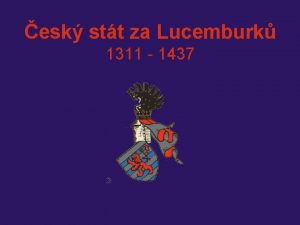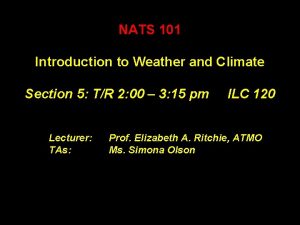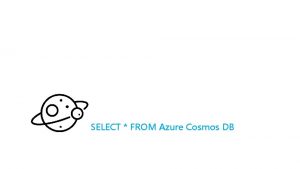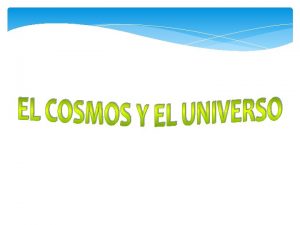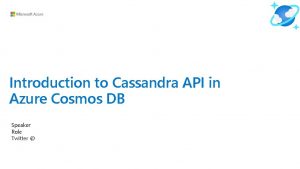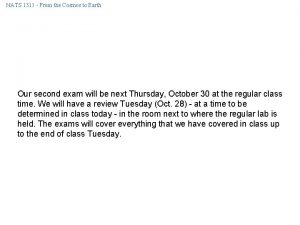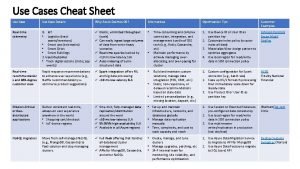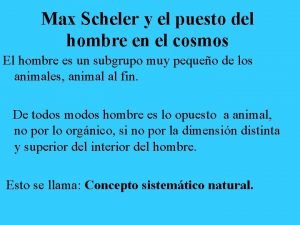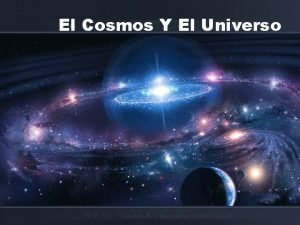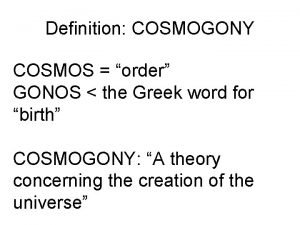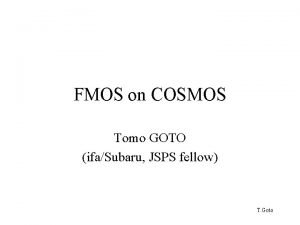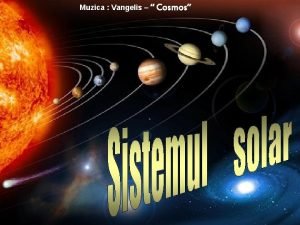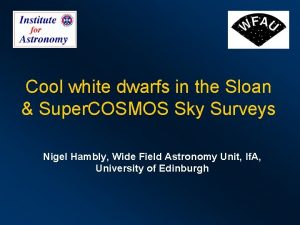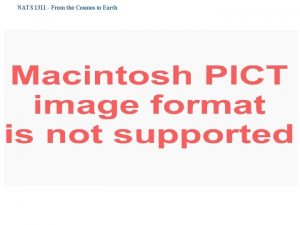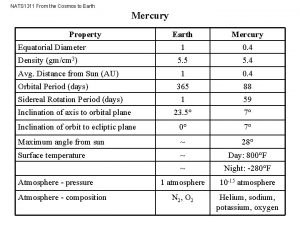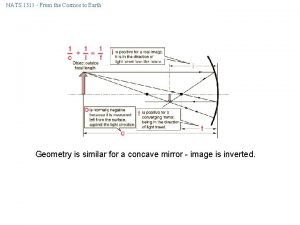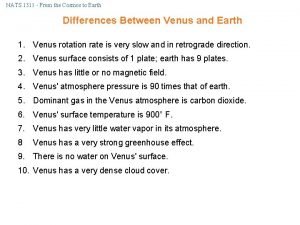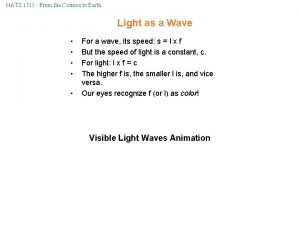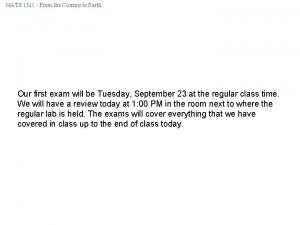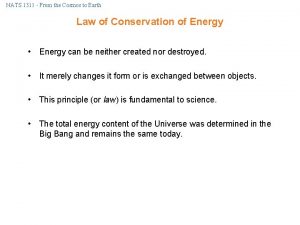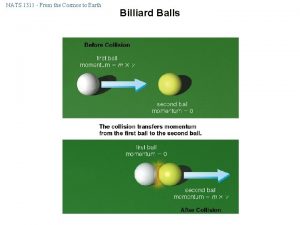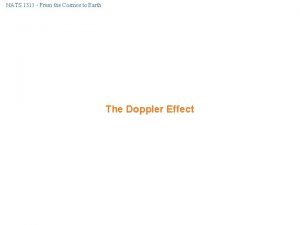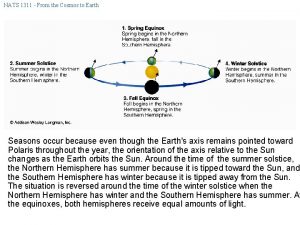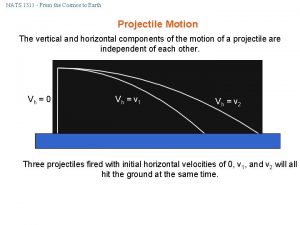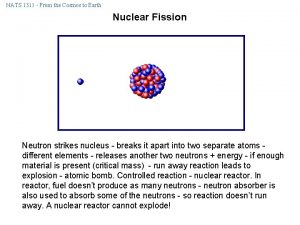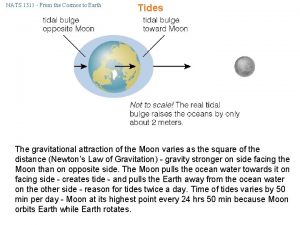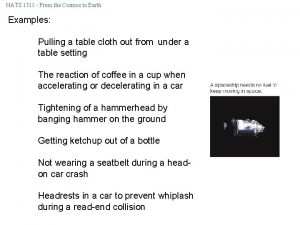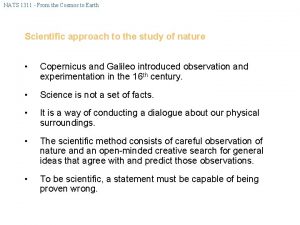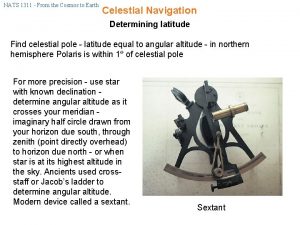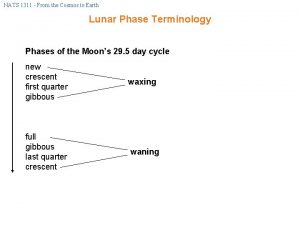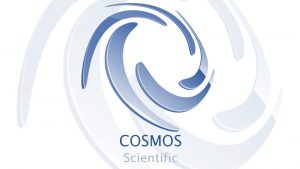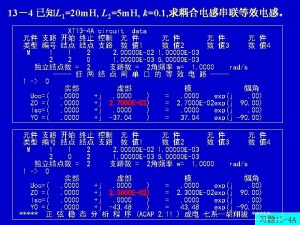NATS 1311 From the Cosmos to Earth NATS













































- Slides: 45

NATS 1311 - From the Cosmos to Earth

NATS 1311 - From the Cosmos to Earth Jovian Planets Outer planets visited by few spacecraft - Neptune and Uranus only by Voyager 2 flybys - visited Jupiter, Saturn, Uranus, and Neptune during great planet line-up of the 1980’s - only time in hundreds of years possible. Voyager 2 now about twice as far as Pluto - nearing Oort cloud - still transmitting data

NATS 1311 - From the Cosmos to Earth Galileo Spacecraft The Galileo spacecraft arrived at Jupiter in 1995 after a 6 -year journey. Very convoluted trajectory with multiple planetary flybys for gravitational boost assistance. Dropped probe into Jupiter atmosphere. Flew into Jupiter at end of life in 2003.

NATS 1311 - From the Cosmos to Earth Jupiter The first of the Jovian planets - largest in the solar system - 1000 Earths could fit inside. No solid surface - primarily hydrogen and helium. Dynamic weather systems with colorful latitudinal bands, atmospheric clouds and storms - the cloud patterns change within hours or days.

NATS 1311 - From the Cosmos to Earth The Great Red Spot A long lived storm - several hundred years old - large enough to swallow two or three Earths.

NATS 1311 - From the Cosmos to Earth The Jovian System Jupiter has over 60 moons.

NATS 1311 - From the Cosmos to Earth Io - the most volcanically active place in the solar system Ganymede - larger than Mercury may have a subsurface ocean

NATS 1311 - From the Cosmos to Earth Volcanoes on Io Caused by tidal heating created by tremendous gravitational pull of Jupiter.

NATS 1311 - From the Cosmos to Earth Cassini Spacecraft The Cassini spacecraft arrived at Saturn in 2004 after a 7 -year journey. Like Galileo, it had a very convoluted trajectory with multiple planetary flybys for gravitational boost assistance - now providing some of the most spectacular images and data ever as it orbits the planet. Also dropped a probe into Titan’s atmosphere.

NATS 1311 - From the Cosmos to Earth Saturn Second largest planet - only slightly smaller diameter than Jupiter but much less dense - about 1/3 the mass of Jupiter. The most spectacular planet with its beautiful rings. (All four Jovian planets have rings but Saturn’s are the only ones visible through a small telescope. )

NATS 1311 - From the Cosmos to Earth Saturn’s Rings The Cassini Division Composed primarily of small particles of rock and ice - this is a picture from the Cassini spacecraft that arrived at Saturn in June after a seven-year journey.

NATS 1311 - From the Cosmos to Earth The Saturn System Saturn has over 50 known moons.

NATS 1311 - From the Cosmos to Earth Mimas - the ‘Death Star”. Collision with large asteroid nearly destroyed Mimas and created the “Darth Vader” crater Titan - Saturn’s largest moon - larger than Mercury. Blanketed by a thick atmosphere - only moon in the solar system with one. Thought to be similar to conditions on Earth when life first formed.

NATS 1311 - From the Cosmos to Earth Titan’s Atmosphere

NATS 1311 - From the Cosmos to Earth The last picture that Voyager 2 took before departing for Uranus and Neptune.

NATS 1311 - From the Cosmos to Earth Uranus Much smaller than Jupiter but still larger than Earth. Relatively featureless pale blue-green color caused by methane gas. Uranus is tipped on its side compared to the other planets - probably the results of a cataclysmic collision early in its lifetime.

NATS 1311 - From the Cosmos to Earth The Uranus System Uranus has over 21 moons.

NATS 1311 - From the Cosmos to Earth Titania - largest moon of Uranus. Ariel - long rift valleys stretch across the entire surface - canyons much like the ones on Mars - appear as though they have been smoothed by a fluid. Fluid could not have been water - water acts like steel at these temperatures. Flow marks possibly made by ammonia, methane or even carbon monoxide.

NATS 1311 - From the Cosmos to Earth Neptune Last of the Jovian planets. Similar to Uranus only bluer. A dynamic planet with several large, dark spots reminiscent of Jupiter’s hurricane-like storms. The largest spot - the Great Dark Spot - is about the size of the earth and is similar to the Great Red Spot on Jupiter. Has the strongest winds on any planet.

NATS 1311 - From the Cosmos to Earth Triton Largest moon of Neptune (13 known). Coldest world in the solar system - about -450ºF - reflects more sunlight than Pluto. Only moon with retrograde motion orbits in opposite direction of Neptune’s rotation. Indicates was probably captured.

NATS 1311 - From the Cosmos to Earth The Formation of the Solar System

NATS 1311 - From the Cosmos to Earth Origin of the Solar System Theory must explain the data 1. Large bodies in the Solar System have orderly motions. There are two types of planets. 2. – – 3. 4. small, rocky terrestrial planets large, hydrogen-rich Jovian planets Asteroids and comets exist in certain regions of the Solar System There are exceptions to these patterns.

NATS 1311 - From the Cosmos to Earth Theories of Solar System Formation The nebular hypothesis - Our solar system formed from gravitational collapse of an interstellar cloud of gas • First proposed by German philosopher Immanuel Kant (1755) and French mathematician Pierre-Simon Laplace (1795) Close encounter hypothesis - solar system formed from debris left over from a near-collision of Sun and another star • Gained popularity in first half of 20 th century • Discarded - could not account for observed orbital motions neat division of planets into two categories • Required highly improbable event - inconceivable it could have accounted for many other stars now known to have planets

NATS 1311 - From the Cosmos to Earth Nebular Theory – our Solar System formed from a giant, swirling cloud of gas and dust. Depends on two principles of Physics: • Law of Gravity gravitaional potential energy heat • Conservation of angular momentum and • Basic chemistry

NATS 1311 - From the Cosmos to Earth The Solar Nebula • The nebular theory holds that our Solar System formed out of a nebula which collapsed under its own gravity. • observational evidence – We observe stars in the process of forming today. – The are always found within interstellar clouds of gas. newly born stars in the Orion Nebula solar nebula – name given to the cloud of gas from which our own Solar System formed

NATS 1311 - From the Cosmos to Earth Gravitational Collapse • The solar nebula was initially somewhat spherical and a few light years in diameter. – very cold – rotating slightly • It was given a “push” by some event. – perhaps the shock wave from a nearby supernova • As the nebula shrank, gravity increased, causing collapse. • As the nebula “fell” inward, gravitational potential energy was converted to heat. – Conservation of Energy • As the nebula’s radius decreased, it rotated faster – Conservation of Angular Momentum

NATS 1311 - From the Cosmos to Earth Original cloud large and diffuse - began to collapse. Final density, shape, size, and temperature the result of three processes: • Heating - cloud heated up due to conservation of energy - as cloud shrank, gravitational energy converted to kinetic energy - collisions converted KE into random motions of thermal energy - density and temperature greatest at center • Spinning - conservation of angular momentum caused rotation to increase as cloud collapsed all material didn’t collapse to middle because the greater the angular momentum of a cloud the more spread out it will be. • Flattening - cloud flattened to a disk - different clumps of gas collided and merged - random motion of clumps became average motion became more orderly flattening original cloud’s lumpy shape - orbits also became more circular

NATS 1311 - From the Cosmos to Earth Collapse of Solar Nebula Animation

NATS 1311 - From the Cosmos to Earth Formation of Protoplanetary Disk Animation

NATS 1311 - From the Cosmos to Earth Flattening of the Solar Nebula • As the nebula collapsed, clumps of gas collided and merged. • Their random velocities averaged out into the nebula’s direction of rotation. • The spinning nebula assumed the shape of a disk.

NATS 1311 - From the Cosmos to Earth Formation of Protoplanetary Disk By the time solar nebula had shrunk to 200 AU, became flattened, spinning disk - called a protoplanetary disk The Sun formed in the very center of the nebula. –temperature & density were high enough for nuclear fusion reactions to begin The planets formed in the rest of the disk. Three processes - heating, spinning, flattening - produced orderly motions. Explains: –all planets lie along one plane (in the disk) –all planets orbit in one direction (the spin direction of the disk) –the Sun rotates in the same direction –the planets would tend to rotate in this same direction –most moons orbit in this direction –most planetary orbits are near circular (collisions in the disk)

NATS 1311 - From the Cosmos to Earth Strong Support for the Nebular Theory • • • Computer simulations can reproduce most of the observed motions We have observed disks around other stars. These could be new planetary systems in formation. Pictoris AB Auriga

NATS 1311 - From the Cosmos to Earth Proplyds - disks of dust and gas surrounding newly formed stars. - of the five stars - all pre main sequence - in this field which spans about 0. 14 light years, four appear to have associated proplyds - three bright ones and one dark one seen in silhouette against the bright nebula. - more complete survey of 110 stars in the region found 56 with proplyds.

NATS 1311 - From the Cosmos to Earth Disks seen only in silhouette, - the absence of emission lines at an edge indicates that they are not being illuminated by ionizing photons or flux is so low that the emission is less than that of the background nebula. - may be located within the foreground

NATS 1311 - From the Cosmos to Earth Some bright proplyds have dark disks silhouetted against both the background nebula as well as the ionization fronts of the proplyd. - bright cusp, and extended comet-like tails. - well defined axes tended to be pointed toward an ionizing star. - form envelopes of dust as protoplanetary disks overtaken by the ionization front.

NATS 1311 - From the Cosmos to Earth Stellar Jets Forming stars often emit jets of gas out their north and south poles

NATS 1311 - From the Cosmos to Earth Stellar Jets Gases clumped - could provide insights into the nature of the disk collapsing onto the star. Beaded jet structure "ticker tape" recording of how clumps of material have, episodically, fallen onto the star. - jets "wiggle" along their multi-trillion-mile long paths, suggesting the gaseous fountains change their position and direction. - may result from the gravitational influence of - ubiquitous in the universe - occur over a vast range of energies and physical scales, in a variety of phenomena. HH 30

NATS 1311 - From the Cosmos to Earth XZ Tauri - young system with two stars orbiting each other - separated by about 6 billion kilometers (about the distance from the Sun to Pluto) - shows bubble of hot, glowing gas extending nearly 96 billion kilometers from this young star system. - appears much broader than the narrow jets seen in other young stars, but it is caused by the same process - the ejection of gas from a star.

NATS 1311 - From the Cosmos to Earth Galactic Recycling After Big Bang hydrogen and helium (with a little Lithium) only elements present. Heavier elements produced in stars - very heavy elements produced in massive stellar explosions - contents scattered - coalesce to form new stars and planets. Most of matter in universe still hydrogen and helium - 98% of solar system made up of these two elements

NATS 1311 - From the Cosmos to Earth Building the Planets Condensation – process in which solid or liquid particles form in a gas Elements and compounds began to condense (i. e. solidify) out of the nebula. Created “seeds” around which gravity could ultimately build planets. Condensation of different materials dependent on temperature.

NATS 1311 - From the Cosmos to Earth Temperature in solar nebula dependent on distance from center - • In innermost regions where Sun formed, temperature greater than 1600 K - too hot for condensation - remained gaseous • Within Mercury’s orbit temperature less than 1600 K - metals could condense • Near Mercury’s orbit temperature less than 1300 K - rock could condense - condensation increased as distance from center increased • Near asteroid belt, carbon rich materials plus minerals with small amount of water could condense • Beyond asteroid belt was frost line - temperature less than 150 K hydrogen compounds condensed into ices - abundance of seeds much greater due to abundance of hydrogen - three times as much as metal and rock combined

NATS 1311 - From the Cosmos to Earth The Frost Line So only rocks and metals condensed within 3. 5 AU of the Sun - the socalled frost line. Hydrogen compounds (ices) condensed beyond the frost line. Therefore, temperature distribution - not gravity - resulted in formation of terrestrial and Jovian planets - orbit of particle does not depend on size or density

NATS 1311 - From the Cosmos to Earth Temperature Distribution of Disk Animation

NATS 1311 - From the Cosmos to Earth Accretion accretion - process of growth by colliding and sticking together - • small grains stick to one another via electromagnetic force - static electricity - until they are massive enough to attract via gravity to form: planetesimals - pieces of planets - sizes and composition reflect seeds from which they were accreted • combine near the Sun to form rocky planets • combine beyond the frostline to form icy planetesimals which… • capture H/He far from Sun to form gas planets Small planetesimals can have almost any shape - small asteroids and comets. Larger planetesimals become more spherical under influence of gravity - planets and moons.

NATS 1311 - From the Cosmos to Earth Accretion and Formation of Planets Animation
 Math 1311
Math 1311 Math 1311
Math 1311 1311 korunovace
1311 korunovace Nats weather
Nats weather Nats stipend reimbursement
Nats stipend reimbursement Cosmos db udf
Cosmos db udf Dave toback cosmos
Dave toback cosmos Imagenes de cosmos y el universo
Imagenes de cosmos y el universo Cosmos db query optimization
Cosmos db query optimization Cosmos cassandra api
Cosmos cassandra api Cosmos air
Cosmos air Micro cosmos psychology
Micro cosmos psychology Avax vs cosmos
Avax vs cosmos Cosmos db cheat sheet
Cosmos db cheat sheet Concepción del hombre
Concepción del hombre El cosmos y el universo
El cosmos y el universo Azure cosmos db: sql api deep dive online courses
Azure cosmos db: sql api deep dive online courses What does cosmos mean in greek
What does cosmos mean in greek Cosmos ssp
Cosmos ssp Cosmos vangelis
Cosmos vangelis Super cosmos
Super cosmos Azure cosmos db query cheat sheet
Azure cosmos db query cheat sheet Cosmos db ru calculator
Cosmos db ru calculator Undergraduate meaninh
Undergraduate meaninh Db
Db Conceito rosacruz do cosmos
Conceito rosacruz do cosmos Lời thề hippocrates
Lời thề hippocrates Các loại đột biến cấu trúc nhiễm sắc thể
Các loại đột biến cấu trúc nhiễm sắc thể Vẽ hình chiếu đứng bằng cạnh của vật thể
Vẽ hình chiếu đứng bằng cạnh của vật thể Phản ứng thế ankan
Phản ứng thế ankan Các môn thể thao bắt đầu bằng tiếng chạy
Các môn thể thao bắt đầu bằng tiếng chạy Sự nuôi và dạy con của hươu
Sự nuôi và dạy con của hươu điện thế nghỉ
điện thế nghỉ Một số thể thơ truyền thống
Một số thể thơ truyền thống Thế nào là sự mỏi cơ
Thế nào là sự mỏi cơ Trời xanh đây là của chúng ta thể thơ
Trời xanh đây là của chúng ta thể thơ Voi kéo gỗ như thế nào
Voi kéo gỗ như thế nào Frameset trong html5
Frameset trong html5 Số.nguyên tố
Số.nguyên tố Thiếu nhi thế giới liên hoan
Thiếu nhi thế giới liên hoan Phối cảnh
Phối cảnh Các châu lục và đại dương trên thế giới
Các châu lục và đại dương trên thế giới Thế nào là hệ số cao nhất
Thế nào là hệ số cao nhất Hệ hô hấp
Hệ hô hấp Tư thế ngồi viết
Tư thế ngồi viết đặc điểm cơ thể của người tối cổ
đặc điểm cơ thể của người tối cổ


